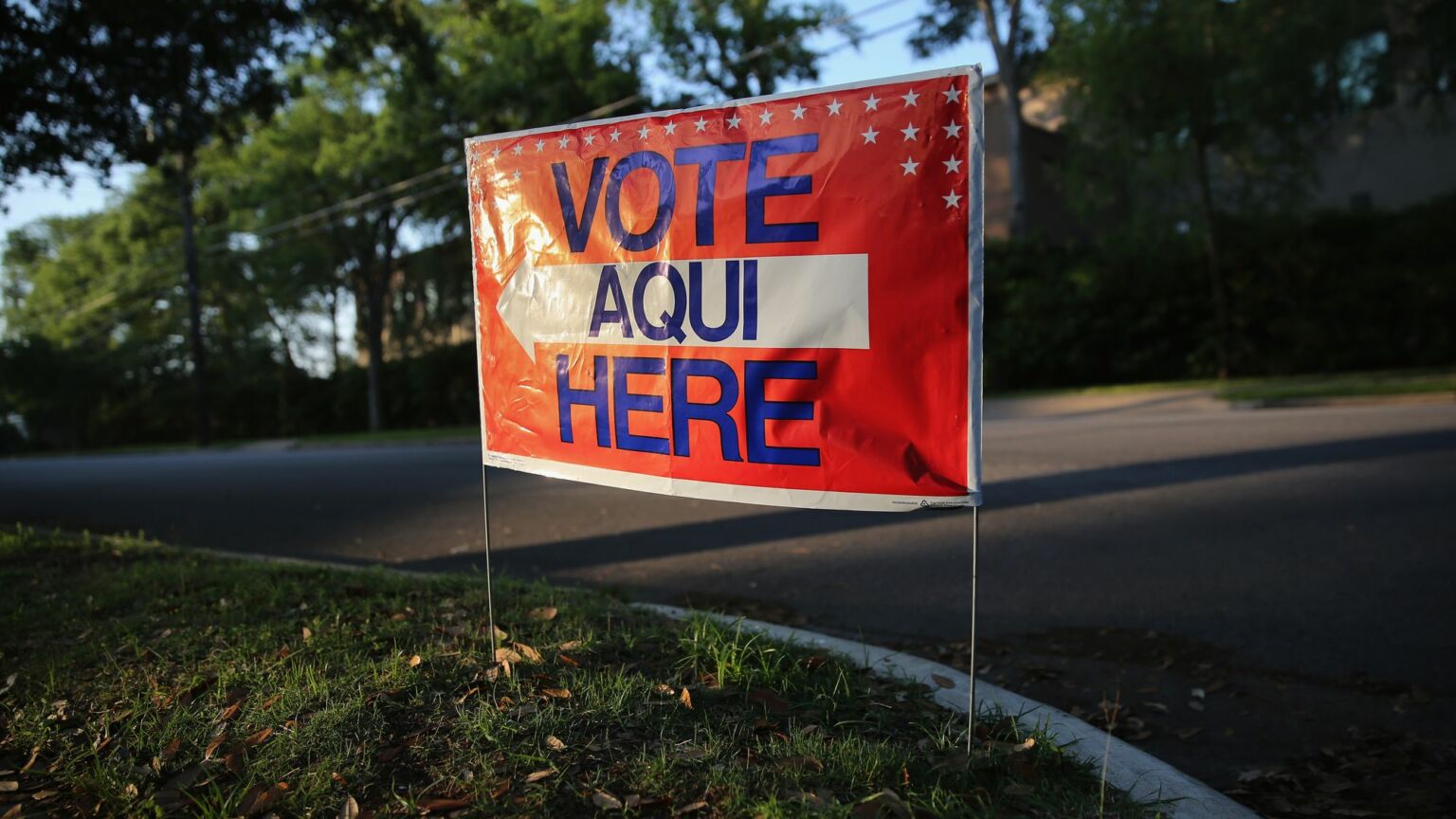2024 will be the Latino election
America's largest racial minority could swing the vote for Trump.

Want to read spiked ad-free? Become a spiked supporter.
The key voting bloc in American politics is not the black or Evangelical vote – it’s the Latinos. Now by far the largest racial minority in the nation, Latinos are also the great contested electoral territory.
Latinos’ political trajectory is complex and increasingly uncertain. In the past, Democrats imagined that Latinos, being ‘people of colour’, would follow the African-American pattern of near-automatic allegiance to their party. Progressives in publications like Salon scoffed at the notion that Latinos would ever head to the right.
But Latinos leaving the Democrats is exactly what has been happening. Republican support among Hispanic voters has grown by 10 points since 2018. In fact, in 2020, the odious Donald Trump increased his share of the Latino vote by eight per cent to 39 per cent, the highest percentage for a Republican since George W Bush won 44 per cent in 2004. Trump improved his margins in 78 of the US’s 100 majority-Hispanic counties.
Latino identification with the Democrats, notes Gallup, now sits at its lowest level ever. A Reuters / Ipsos survey in December revealed that Trump might actually be leading Joe Biden among Latino voters. Even a close contest could be catastrophic for Biden. Indeed, if these trends persist, it will be hard to see how he can get a second term.
Where Latinos go politically is important not just this year but also for the foreseeable future. America’s Latino population grew by 23 per cent between 2010 and 2020 to 62million people. Latinos now account for 19 per cent of the US population. By 2030, they are expected to constitute 21 per cent. Moreover, Latinos are fuelling the US economy. In 1990, they accounted for just under 11million workers, a figure that rose to 29million by 2020, and is projected to reach nearly 36million by 2030.
Due to generally lower rates of electoral participation than other sections of American society, Latinos’ political power has tended to lag behind their economic heft. But this is changing. According to the National Association of Latino Elected and Appointed Officials, more than 17.5million Latino voters are expected to cast ballots this November nationwide, representing a 6.5 per cent increase on their turnout for the 2020 presidential election, and an increase of 38 per cent on their 2016 turnout. More than one in every 10 voters will be Latino this year.
Overall, the popular image of Latinos presented in the media, largely as gang members or oppressed workers, tells only a part of the story. Rather than angry ‘people of colour’ looking for an American version of Fidel Castro, their political orientation is ambiguous. Among recent Hispanic immigrants, notes one recent study, 62 per cent do not identify with either party.
According to Pew, Latinos are generally in favour of expanded government largesse, but they’re also culturally conservative. As Northwestern University professor Geraldo Cadava puts it, ‘their complex histories have given them good reasons to be Democrats, but also good reasons to be Republicans’.
The economic progress of Latinos, observes Stanford professor Keith Humphreys, makes a tilt towards the GOP more likely. They already enjoy longer lifespans than white Americans by three years. Latino wealth has grown in the past decade roughly twice as fast as that of the general population. Their overall labour-participation rates are higher than all other ethnic groups. Over the past 20 years, Latinos nationwide have experienced the largest reduction in poverty, too.
The key to reaching Latinos lies in appealing to their aspirations and sense of patriotism. Generally more optimistic about the future than non-Hispanic whites, they still believe in and cherish the American Dream. When pollsters asked Latinos what was needed to achieve success in the US, 94 per cent said ‘a strong work ethic and working hard’. Latinos also boast some of the highest rates of voluntary enlistment and represent the fastest growing population in the military, making up about 16 per cent of all those on active duty.
These aspirations are not much appreciated by progressives, who generally reject the American Dream, embrace green austerity and reject the nation state. As one Democratic Latino political strategist told Politico, woke obsessions like defunding the police and using the gender-neutral term ‘Latinx’, have little currency among the bulk of the Latino population.
At the same time, Latinos are increasingly ditching the deep-blue West Coast barrios and East Coast big cities and heading instead into the redder south and middle of the US. In one key battleground state, Pennsylvania, there are some 600,000 Latino voters. Although most are Democrats, Trump and the Republicans have been gaining ground and even winning elections in heavily Latino constituencies there.
The palpable shift of Latino voters away from the Democrats is driven by concerns over immigration, culture and, most decisively, economics.
As a recent immigrant group, Latinos have traditionally favoured a liberal immigration policy. And compared with most Americans, they still do. But the most recent Pew polling finds that roughly 40 per cent think there is now a border crisis and they dislike the Biden administration’s lax border-enforcement policies. A full third now favours more deportations – a position once rare among Latinos.
The changing attitudes are most marked among those who experience the full impact of the largely undefended border. This is particularly true in south Texas, where formerly strongly Democratic areas have shifted more towards the GOP. Hillary Clinton won Zapata County on the Mexico border by almost 33 points in 2016, but it turned red in 2020. In Webb County, another border county, the Republican vote doubled between the 2016 and 2020 elections. And in Starr County, south of Webb, Republicans recorded a 55 per cent vote increase in 2020 on their previous total in 2016, the single biggest swing to the right in the entire US.
There’s also resentment building among Latino communities in cities like New York, where an influx of migrants is blamed for growing street-level disorder, as well as for greater competition for scarce resources like medical services, schools and parks. Roughly half of all Latinos, notes Pew, associate the current immigration wave with increased crime in their communities. In addition, less skilled immigrants compete with already struggling working-class citizens. As the Congressional Budget Office warns, this will have a negative impact on the salaries of low-income workers, many of whom are Latino.
Thanks to the influence of the progressive left, Democratic politicians are largely ignoring these concerns, which they associate with Trumpist racism. The same head-in-the-sand approach leads them to ignore the generally socially conservative tilt of Latinos on social issues, from parental rights to abortion to police reform.
Indeed, Latinos tend to be considerably more socially conservative than most native-born Americans. Minorities and immigrants, including from south of the border, have been prominent in parents’ protests against woke education, including in highly diverse places like Jackson Heights, Queens and the Maryland suburbs, as well as in immigrant-rich communities like Glendale, California. They also favour restrictions on abortion by a nearly 10-point margin over other ethnic groups.
The most critical issue for Latinos is likely to be the economy. Like earlier immigrants, Latinos are clustered in what my colleague Soledad Ursua calls the ‘carbon economy’ – namely, manufacturing, logistics, agriculture and construction. As shown by American Community Survey data, Latinos account for more than two-fifths of the US food-production and forestry workforce, over a third of ground clearing and maintenance staff and just under a quarter of workers in logistics and manufacturing. In states like California, they represent roughly 60 per cent of all manufacturing and construction workers.
Many of these jobs are likely to be wiped out by the current green agenda championed by the Biden administration and by the left more broadly. Overall, according to a Chamber of Commerce report, a full national ban on fracking, widely supported by greens, would cost 14million jobs – far more than the eight million jobs lost during the global financial crisis. In heavily Latino Texas alone, it could cost a million generally good-paying jobs. Will so-called green jobs come to the rescue? Unlikely. Barely one per cent of people losing ‘dirty jobs’ find work in a ‘green’ one, according to a recent University of Pennsylvania study.
The negative effects of green policies are particularly clear in California. Although some of the environmental improvements, notably cleaner air, have benefitted all Californians, the current climate agenda undermines the very kind of jobs that offer upward mobility for many Latinos. Between 1990 and 2021, according to the Census of Employment and Wages, almost 800,000 manufacturing jobs have been lost in California. Other critical, largely Latino sectors, like trucking and logistics, face similar pressures from green regulations.
Many Latinos may remain Democratic for now, but their ubiquity in blue-collar jobs or running small businesses, seems to be driving them to Trump. Young, male, working-class voters are tilting to the right just as we have seen in Italy, Argentina, Sweden, Greece and Spain. In the US, many of them are Latino.
Essentially, Latinos, like most Americans, are driven by middle-class aspirations. A majority own their own homes. But that rate is far higher in the likes of Texas and Florida than in California or New York. Within California, the Latino population has risen in precisely those places, like Riverside, where houses are more affordable.
In all these cases, Latinos are moving away from blue regions to increasingly redder ones where they do better economically. The real income for Latinos, adjusted for cost of living, is far higher in places like Atlanta or Dallas than in Los Angeles or California. Critically, 71 per cent of all Latino households in New Mexico, and 59 per cent in Texas, own their homes, compared with a dismal 45 per cent in California.
In order to limit the current movement of Latinos to the GOP, author Ruy Texeira says that the Democrats need to ditch the racial identity politics and focus instead on addressing core economic issues. Indeed, the biggest worries for Latinos are inflation and the economy, well ahead of climate change or concern with Trump’s potential threat to democracy.
The key to appealing to this critical constituency lies not in appealing to fears, but in focussing on aspirations – for a better education, homeownership, a decent job and opportunity for entrepreneurship. The parties, or politicians, who can appeal most to those aspirations, will not only win the Latino vote, they could also dominate American politics for decades to come.
Joel Kotkin is a spiked columnist, the RC Hobbs presidential fellow in Urban Futures at Chapman University and author, most recently, of The Coming of Neo Feudalism: A Warning to the Global Middle Class, published by Encounter.

Matt Ridley and Brendan O’Neill – live and in conversation
Thursday 21 March – 7pm to 8pm GMT
This is a free event, exclusively for spiked supporters.
Picture by: Getty.
Who funds spiked? You do
We are funded by you. And in this era of cancel culture and advertiser boycotts, we rely on your donations more than ever. Seventy per cent of our revenue comes from our readers’ donations – the vast majority giving just £5 per month. If you make a regular donation – of £5 a month or £50 a year – you can become a and enjoy:
–Ad-free reading
–Exclusive events
–Access to our comments section
It’s the best way to keep spiked going – and growing. Thank you!









Comments
Want to join the conversation?
Only spiked supporters and patrons, who donate regularly to us, can comment on our articles.